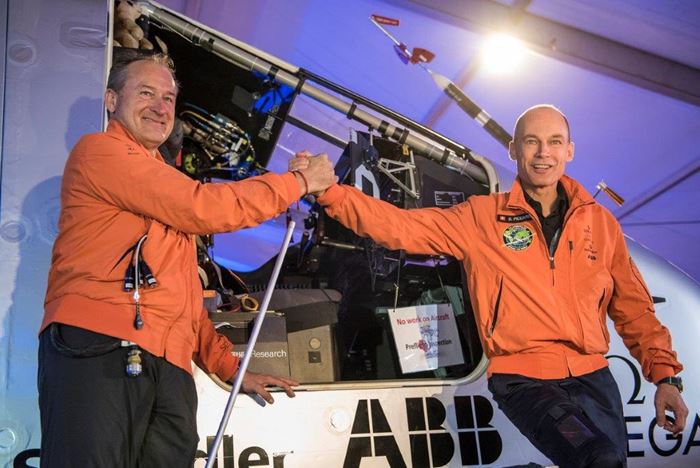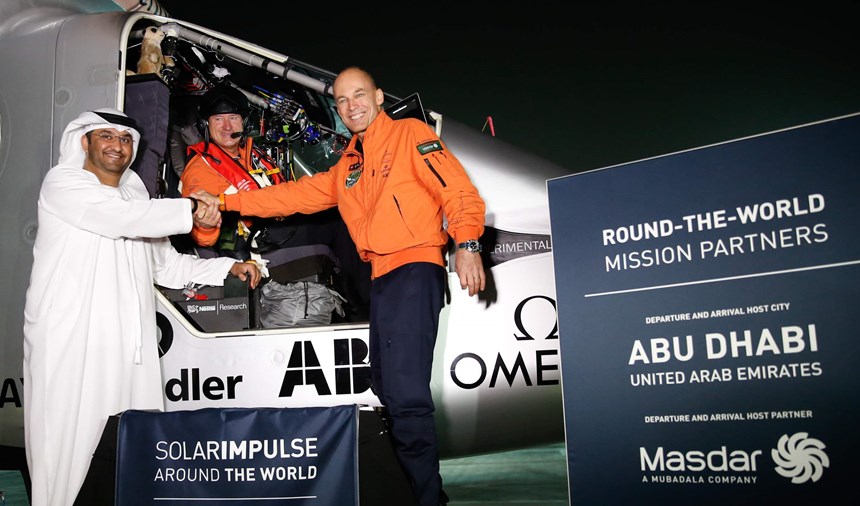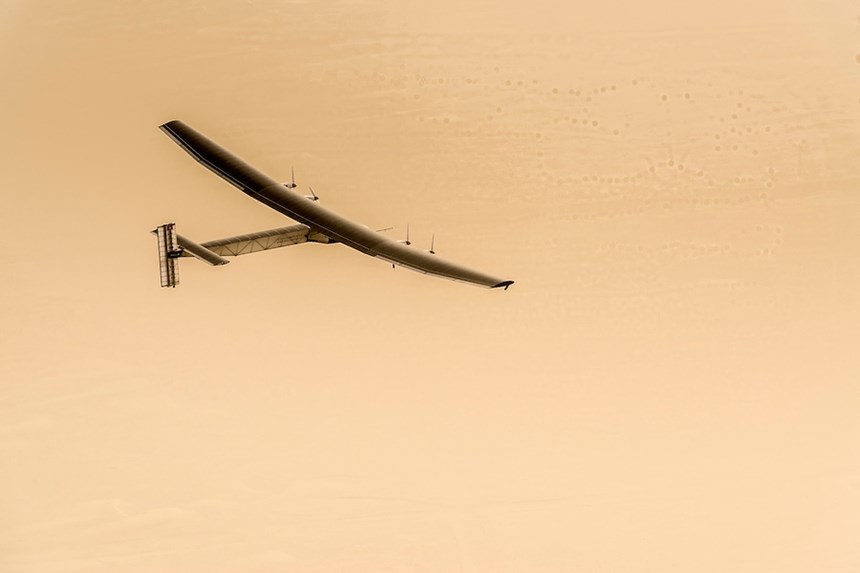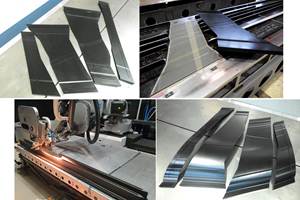Solar Impulse 2 Round-the-World attempt begins
Pilots André Borschberg and Bertrand Piccard successfully complete the first leg of what is intended to be a five month global aerial circumnavigation.
Share
Read Next
Energized only by sunlight taken in by the solar panels arrayed on its horizontal surfaces, the electric-prop-driven Solar Impulse (Si2) aircraft took off the morning of March 9 from Abu Dhabi, UAE, under the watchful eyes of the Solar Impulse team there and in tis Mission Control Center (MCC) in Monaco. André Borschberg lifted off in Si2 at 7:12 a.m. (GMT +4) on Monday, carrying no backup fuel supply or alternative means of propulsion, headed for Muscat (Oman) before crossing the Arabian Sea to Ahmedabad (India) on the first leg of what is intended to be a Round-The-World Flight. Borschberg's partner and the aircraft's co-developer Bertrand Piccard was to take the reins in Oman and continue onward to Ahmedabad. Co-pilots Piccard and Borschberg, in fact, will continue to take turns flying the single-seater experimental solar aircraft, which is able to fly with what its development team calls "perpetual endurance."
The company noted, on the occasion of the event, that it has taken 12 years for Piccard (the development program's initiator and chairman) and Borschberg (founder and CEO), to finally be in a position to attempt to make their dream a reality — demonstrating the importance of renewable energy conceived through a pioneering spirit and innovation.
Capable of flying over oceans for several days and nights in a row, Solar Impulse is scheduled, during the RTW trip, to travel 35,000 km in 25 days over the course of roughly five months. Curignn that time, Si2 will pass over the Arabian Sea, India, Myanmar, China and the Pacific Ocean. After crossing the Atlantic Ocean, the final legs include a stop-over in Southern Europe or North Africa before completing the Round-the-World flight at its final destination in Abu Dhabi, Solar Impulse’s official host city. During the 12 scheduled stops, the Solar Impulse team and its partners will organize public events for governments, schools and universities.
Solar Impulse is an ambitious scientific project, say trip organizers, but for those passionate about exploration, the visionary journey is also a strong message for clean technologies.
Supported by Prince Albert of Monaco, UAE Minister of State and Chairman of Masdar H.E. Dr. Sultan Al Jaber, Richard Branson and Al Gore, the #FutureIsClean initiative has been launched on www.solarimpulse.com to recruit the severely needed support for the adoption of clean technologies worldwide. Of the chalenge ahead, Piccard and Borschberg said: "We are very ambitious in our goal, but modest, given the magnitude of the challenge. This is an attempt, and only time will tell if we can overcome the numerous weather, technical, human and administrative issues."
On the tarmac before of the take-off, His Excellency Dr. Sultan Al Jaber, UAE Minister of State and Chairman of Masdar, wished pilots Piccard and Borschberg a safe and successful journey. "The historic day has finally arrived. After months of intense preparation and collaboration with Masdar, Solar Impulse 2 is ready to embark on its attempt to circumnavigate the world, using only the sun's energy, demonstrating the power of clean technology. This journey is a moment of national pride for the United Arab Emirates, as Abu Dhabi helped the mission team prepare for success. Together, we inspired thousands of students and professionals across the country, and I'm confident that such community engagement initiatives will be replicated across the globe, capturing the hearts and imaginations of the world and reaching our collective goal of a cleaner future."
At approximately 10:00 am local time (GMT +4), Solar Impulse 2 was expected to enter Omanian airspace near Al Ain at an altitude of about 3,600 meters, ascend in the direction of Muscat (5,800 meters) and land at Muscat International Airport about 7 p.m. local time (GMT +4). The BBC reported late Monday evening that that timetable had indeed been accurate. Si2 had touched down softly and safely at 7:14 p.m. after a 12-hour flight.
About the Solar Impulse project
Solar Impulse is an airborne laboratory, genuinely made from technological solutions developed by a multidisciplinary team of 80 specialists and more than a hundred partners and consultants. Si2 is the largest aircraft ever built with such a low weight, equivalent to that of a small car. With a wing covered by more than 17,000 solar cells greater than a Boeing 747, the plane can fly up to an altitude of 8,500 at speeds ranging from 50 to 100 km/h. The pilots, Piccard and Borschberg, will be required to demonstrate extraordinary endurance under extreme conditions, living in a 3.8m3 unpressurized cockpit, unheated, with external temperatures ranging from -40°C to +40°C. Crossing the Pacific and Atlantic Oceans in five days and nights will certainly represent the highlights of this adventure.
Related Content
The lessons behind OceanGate
Carbon fiber composites faced much criticism in the wake of the OceanGate submersible accident. CW’s publisher Jeff Sloan explains that it’s not that simple.
Read MorePEEK vs. PEKK vs. PAEK and continuous compression molding
Suppliers of thermoplastics and carbon fiber chime in regarding PEEK vs. PEKK, and now PAEK, as well as in-situ consolidation — the supply chain for thermoplastic tape composites continues to evolve.
Read More3D-printed CFRP tools for serial production of composite landing flaps
GKN Aerospace Munich and CEAD develop printed tooling with short and continuous fiber that reduces cost and increases sustainability for composites production.
Read MoreTU Munich develops cuboidal conformable tanks using carbon fiber composites for increased hydrogen storage
Flat tank enabling standard platform for BEV and FCEV uses thermoplastic and thermoset composites, overwrapped skeleton design in pursuit of 25% more H2 storage.
Read MoreRead Next
Developing bonded composite repair for ships, offshore units
Bureau Veritas and industry partners issue guidelines and pave the way for certification via StrengthBond Offshore project.
Read MorePlant tour: Daher Shap’in TechCenter and composites production plant, Saint-Aignan-de-Grandlieu, France
Co-located R&D and production advance OOA thermosets, thermoplastics, welding, recycling and digital technologies for faster processing and certification of lighter, more sustainable composites.
Read MoreAll-recycled, needle-punched nonwoven CFRP slashes carbon footprint of Formula 2 seat
Dallara and Tenowo collaborate to produce a race-ready Formula 2 seat using recycled carbon fiber, reducing CO2 emissions by 97.5% compared to virgin materials.
Read More
















.jpg;maxWidth=300;quality=90)










